Introduction
Soybean (Glycine max L.) is one of the major leguminous crops cultivated all over the world today with Nigeria as the largest producer in both Western and Central Africa, since its introduction in the early twentieth century (Dugie et al., 2009). Soybean is widely known to be cheap, easily available and a good source of protein compared with expensive animal protein when purchased as Soybeans to be only about 10-20% of the cost of protein from meat, eggs, fish or milk. Soybean is now widely consumed and readily used in the production crude vegetable oil, soymilk, soy yoghurt and dawadawa. In addition to that, a local but good seasoning is also produced from soybean (Iornum, 2012).
The rapid growth in both vegetable and poultry sectors in the past five years (about 30% per annum) has boosted its demand. Benue state is widely known as one of the major cultivators of soybean. The rural farmers which are mostly women produce on small-holder farms averaging not more than a hectare, and as a result, not mechanized. Generally, soybean cultivation starts in May/June with land clearing and harvesting which normally commences in late October through November every year (IITA, 2009).
The processing of soybean in very important as it provides readily available end-products such as cooking oil, flour and soy cheese. Processing soybean into soybean products involves some local level processes such as threshing, winnowing and packaging into marketable forms. Processing of soybean into end-products for example, cooking oil provides utility of form prior to marketing and communication by end users. Rural women farmers not only play a vital role in food production; they also carry out agricultural activities beyond crop production. Also, women take active part in farming, processing and marketing. It is said that out of ten agricultural workers in the world, four are women (Technical Centre of Agriculture and Rural Cooperation CTA, 1993). The role women play in agriculture and the rural society is fundamental to agricultural and rural development in Nigeria and sub Saharan Africa. Women in Africa are said to make up more than one-third of its entire workforce (Ani, 2002).
Reports have shown that soybean has faced some problems surrounding the area of improper processing techniques and use of traditional processing equipment. These problems in most cases, have caused a negative impact in its consumption, its prices as well as its rate of production (Edame and Fonta, 2014). The problems militating against women in soybean enterprise, as well as other agro-based enterprises such as lack of improved technologies, inadequate contact with extension agents, primitive and labour-intensive farm implements which have adverse effects on soy bean processing and marketing both at local and industrial levels (Ashaye, Adegbulugbe and Sanni, 2005).
The relevance of marketing is to meet the basic needs of the society. A good and efficient marketing system accelerates the pace of economic and rural development by encouraging specialization which will invariably lead to increase in output, thereby generating income and provision of incentives to farmers (Abbot and Makeham, 1993). The need to educate rural women who are vital producers, processors and marketers of agricultural products, for e.g. soybean is more important in areas where most of the young women migrate to cities for better paying jobs (Obinne, 1991). Considerable attention should be given to modern soybean processors within the state to be able to meet up with the growing demand of soybean products, for e.g. vegetable oil (USDA, 2008). Report shows that soybean processors in the country are operating below capacity and there is a domestic short fall of all vegetable oil estimated at about 300,000 tons annually with the price of vegetable oil doubling the price at its international level (USDA, 2008).
Awareness has been created among the rural farmers on the need to grow soybean but the issue of processing and storage remains a limiting factor for utilization of the crop. Soybean processing and marketing are complex practices mostly done by women who engage in the difficult aspect of the work due to limited access to technology to reduce drudgery (Omotayo et al., 2007). The relevance of marketing is to meet the basic needs of the society. A good and efficient marketing system accelerates the pace of economic and rural development by encouraging specialization which will invariably lead to increase in output, thereby generating income and provision of incentives to farmers (Abbot and Makeham, 1993).
Women are said to have inadequate access to agricultural information and innovations (Saito and Surling, 1993). As a result of this, considerable attention has to be paid on the role women play in agricultural development and hence, effort should be directed towards improving their conditions in Tarka Local Government Area of Benue. The study therefore aimed at economically assessing rural women participation in processing and making of Soybean in Tarka Local Government Area of Benue State, Nigeria. Specifically, the objectives:
(i) Described the socio-economic characteristics of soybean processors and marketers;
(ii) Identified the different forms of soybean product;
(iii) Identified the different forms of soybean products as well as determined the level of rural women participation;
(iv) Determined the profitability of the processors and marketers of soybean products.
Methodology
The study was conducted in Tarka Local Government Area of Benue State Nigeria. Benue state lies between latitudes 6-8/N of the equator and longitudes 6-10/E of the Greenwich meridian. The state is bounded in the north by Nasarawa State, in the south by Cross River and Enugu States, and in the east and west by Taraba and Kogi states respectively. The state is acclaimed as “Nigeria’s food basket,” because of its rich and diverse agricultural produce and supplies which include: yams, rice, cassava, sorghum, etc. The state also accounts for over 70% of Nigeria’s soybean production. Benue state has about 67,740 sq km with population of about 4,219,444 persons. However, the area under study has a land mass of about 60,000 sq.km and a population of 79,494 persons (NPC, 2006). Tarka LGA is situated north of Gboko LGA in the North-east wing of Benue state. The LGA shares boundaries with Guma, Gwer, Buuku and Gboko Local Government to the North, West, East and South respectively with Wannune as the headquarters with an area of 371km. Annual rainfall ranges between 150-189mm with its peak in May/June and September. The temperature ranges between 210C and 350C (Ezihe, 2013).
Tarka is made up of three (3) administrative districts namely: Mbaji, Mbalahan and Mbachoughul. The two level lands and guinea savanna vegetation with fairly tall sparsely grown trees and grasses favour the growth of tooth root and grain crops simultaneously.
The population of this study consisted of all the processors and marketers of soybean products in some selected markets in Tarka LGA of Benue state. One hundred and nine (109) women from the three (3) districts of its LGA were sampled. These areas included Mbaji, Mbalahan and Mbachoughul. Four (4) markets were sampled to assess the marketing of soybean and soybean products in the area. These markets included Wannune, Asukunya, Tyor-tyu and Gwerche market.
Purposive sampling technique was used to sample soybean processing and marketing in the study area. The sampling procedure for purposive random sampling technique was as follows:
Specific elements which satisfy some predetermined criteria were selected. Based on what the research constitutes a representative sample with respect to the research purpose was outlined. In order to ensure equal representation of the population elements having particular characteristics of interest to the research wee included.
Primary data was used for this study. The data was obtained through the use of structured questionnaires, as well as interview schedule where neither traders could read nor write.
Analytical Techiques
Data from objective (i), (ii) and (iii) were analyzed using simple descriptive statistical tools such as frequency distribution, percentages and tables.
Gross Margin Analysis
Gross margin analysis was used to analyze data on objective (iv). The method for gross margin analysis was outlined as follows:
Gross Margin = Total Revenue – Total Variable Cost ——————- (Equation 1)
(GM) (TR) (TVC)
The total revenue here is the gross income from soybean processing and marketing in Tarka Local Government Area. On the other hand, TVC is the cost incurred on variable inputs. For this study, the variable cost included: cost of packaging, cost of loading as well as offloading and cost of soybean per bag.
Results and Discussion
Socio-Economic Characteristics of the Respondents
The socio-economic characteristics of the processors and marketers in the study area include: age, marital status, household size, level of education, occupation, experience in soybean marketing and their annual income from other sources apart from soybean marketing.
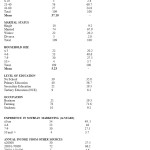 |
Table 1: Distribution of Socio-Economic Characteristics of Soybean Processors and Marketers. Click here to View table |
Results from table 1 showed that majority (97.3%) of the women fell within the active ages of 21 and 60 years, 2.8% fell within the ages of 60 and above. On the other hand, the average age of respondents was 37 years. This implies that soybean processing and marketing operations in the study area has an active work force and are relatively young. Moreso, majority (69.7%) of the women that fell within the ages of 21-40 years were more involved in soybean processing and marketing. This is because soybean processing which is labour-intensive and mostly done by middle-aged women requires much energy for the successful completion of the work. Dugie et al., (2009) made a similar observation that age group influences farm operations.
Findings on marital status show that majority of the respondents are married 67.9%, widowed 20.2%, single 9.2% and divorced 2.8%. High proportion of the respondents that are married suggests that married people would have additional labour supply from the family for soybean operations. However, more of the income from soybean sales will go into the welfare of the family. Result from household size showed that 20.2% of the respondents had household size of less than three, 48.6% had within 4-6 persons, 27.5% had between 7-9 persons and 3.7% had 10 persons and above. This could imply that processing and marketing of soybean in the study area is fairly a large one. The implication is that the smaller the household size, respondents would need to employ hired labour to supplement family labour, thereby ensuring more cost. The average of the household is 5 persons.
Analysis on the educational status of the respondents showed that 36.7% had primary school education, 35.8% had no formal/basic education, 19.3% had secondary school education and 8.2% had tertiary education or an NCE (National Certificate of Education). This could imply that soybean processors and marketers in the study area have low level education. Hence, this will influence the technical and allocative efficiency of soybean operations in terms of adoption and use of innovations, minimizing cost, modern processing techniques, market prices and loan acquisition from financial institutions. Obinne (1991) made a similar observation that the need to educate rural women who are vital producers, processors and marketers of agricultural products is paramount in areas where most of the young women migrate to cities for better paying jobs. On the other hand, analysis on their occupation showed that 19.3% of the respondents are business oriented, 71.6% engage in farming activities and 9.2% are students. This result agrees with the findings of Iornum (2012) that women play a vital role in food production and accounts for 70% of agricultural workers and 80% of food producers.
The survey shows that some of the respondents are active in other enterprises such as sales of food stuff, tailoring and even agricultural products like yams, tomatoes and pepper. Results of the findings on the experience of the soybean marketers shows that majority (50.4%) had above 5 years experience of soybean marketing with an average of 6 years marketing experience
The distribution of annual income for processing and marketing of agricultural products apart from soybeans shows that 27.5% earned less than ₦20,000, while majority (67.9%) earned between ₦20,001 to ₦120,000 and 4.6% earned ₦120,001 and above from other sources other than soybean processing and marketing. The result shows that an average annual income from other sources to be ₦37, 600.
Soybean Products Identified by the Respondents in the Study Area
Table 2 showed that majority (91.7%) of the respondents are involved in processing soybean into dawadawa followed by soymilk 9.6%, Akara 27.%, soyflour 23.9% and soyoil 0.9%. This can be attributed to the fact that dawadawa (nune) is most economical to process (i.e. inputs such as firewood, leaves and soybean) used for the processing. This local seasoning is readily available at little or no cost. Soymilk is the second most processed product 9.6% because it is accepted as an alternative and cheap source of milk compared to dairy milk. The short fall (0.9%) in soy oil could suggest improper processing techniques, high cost of inputs (machineries) and use of additional equipment in soybean processing. This result agrees with the USDA (2009) report which showed that soybean processors in the country are operating below capacity and there is a domestic shortfall in vegetable oil estimated below capacity at about 300,000 tons annually and the price of vegetable oil has doubled twice the international prices.
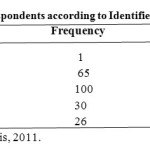 |
Table 2: Distribution of Respondents according to Identified Soybean Products. Click here to View table |
Determining the Level of Women Participation in Soybean Processing
The 4-point scale type was used to determine the level of participation of the women in soybean processing in the study area. The scale was used to measure respondents’ attitude using varying levels of involvement.
The distribution of the respondents reflecting the level of participation showed that majority (99.1%) of the respondents were not involved in processing soybean into soyoil, while 0.9% was very much involved. This may be attributed to the unavailability of processing technologies in the study area. Participation of the women in soymilk business showed that 40.4% of the women were not involved; whereas majority (59.6%) was actively involved in soymilk processing. Data indicated that majority (91.8%) processed soybean into dawadawa, while 8.3% were not involved. This suggested that input for processing were readily available. Moreso, majority of the women were not involved in processing soyflour 76.1% and akara 72.5%. In essence, this could imply that processing soybean into flour and akara was not palatable. Results on winnowing and packaging showed that 91.8% of the women were involved in winnowing and packaging, whereas 8.3% were not involved. In other words, this implied that winnowing, packaging and other-related activities are considered to be basically the role of women.
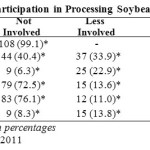 |
Table 3: Level of Women Participation in Processing Soybean. Click here to View table |
Determining the Level of Women Participation in Soybean Marketing
Data regarding the participation of women in marketing soybean was quite minimal. Table 4 showed that 59.6% of the women were not involved in determining the price of soybean; 25.7% were less involved; 11% were much involved; and 3.7% were very much involved. This implied that about 40.4% were engaged in determining the price at varying levels of participation in the study area. This result suggested that women in the study area are the price takers. However, in terms of warehousing, majority (70.6%) of the women were not involved, 13.8% were very much involved. In essence, this could suggest that women in the study area are faced with bottlenecks of inadequate storage facilities and pest/rodents activities while in storage. Women participation in retailing showed that 20.2% of the respondents were not involved in retailing, 16.5% were less involved, 24.8% were much involved, while 37.6% were very much involved. This implied that women tend to process and market soybeans for family consumption, as well as generate income within their locality, so as to enable them take care of themselves. Result on middlemen showed that 56.9% of the women were not involved, 13.8% were less involved. 16.5% were much involved and 12.8% were very much involved. This suggested that there is low level of education amongst the women, as well as lack of information/knowledge about the importance of cooperative and trade association in the study area. Majority (90.0%) of the women participated in transportation within the market at varying levels of participation, while only 9.2% were not involved. The result was so because majority of the women were not far from the market in the transportation of soybeans carrying it on their heads.
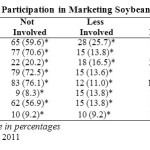 |
Table 4: Level of Women Participation in Marketing Soybean. Click here to View table |
Profitability Analysis of Soybean Processors
Gross margin analysis was used to determine profitability of soybean processing in the study area. It was computed for each product (either for soymilk, dawadawa or soyflour) identified in the study area. Gross margin served as a means of judging cost and returns accruable to either the processors or marketers of soybean into end products in the study area.
The gross margin showed that soymilk ₦5,621.7 per product has the highest individual gross margin per product processed meaning that respondents obtained more benefits in soymilk processing than the other two products with dawadawa with the least gross margin.
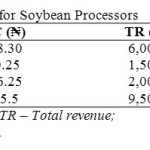 |
Table 5: Gross Margin Analysis for Soybean Processors. Click here to View table |
Table 5 shows the gross margin analysis for soybean marketing. Results showed that most of the cost was incurred on marketing soybean per bag (₦6,068.81/bag) and cost of transportation (₦102.29/bag). This could suggest inadequate infrastructure and high cost of inputs.
The gross margin of soybean marketing was positive (₦1,583.9/bag) which gives an indication that marketing soybeans by the respondents in the study area is profitable. This confirms why the result of the t-test in Table 6 the result showed that there is a significant difference in the total revenue (TR) of ₦7885.8 per bag and the total variable cost (TVC) ₦ 6.084.2 per bag of soybean (t =22.07, d=99, p = 0.01). This implies that marketing of soybean is profitable, since the total revenue ₦7,885.8 is greater than the total variable cost ₦6,084.2.
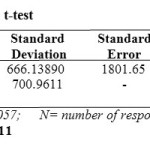 |
Table 6: Profitability Test using t-tes. Click here to View table |
Conclusion
Women in the study area are more active in farm activities apart from their legitimate roles as wives and mothers. Therefore, there is need to encourage female farmers by making available all that is necessary for successful farming. Women participation in agricultural and rural development has long been a central feature for Nigeria agricultural development strategy. Several measures have been taken on how to strengthen the performance of women in the agricultural sector through several policies. However, it seems that adequate attention has not been given to develop appropriate technologies for women. It is therefore, imperative that government policies will focus on creating technologies suitable to the special needs of women.
Recommendation
Soybean processing and marketing is in no doubt a lucrative business, very profitable and should be encouraged. The study shows that soybean-based products are essential in the nutritional status of the people. Based on the findings on the study, extension systems should be more gender-sensitive in designing research agenda and extension programmes that would meet the needs of women, and should make policy makers to become more sensitive in the formulation of policies that would favour women farmers. Moreso, the research systems should however, be made to address the problems of inappropriateness and unavailability. This could be achieved by identifying the information and technological needs of the farmers. Government is thereby advised to give concern for the provision and maintenance of rural infrastructural facilities such as roads, markets and storage facilities to encourage greater output. Also, government should revitalize, as well as improve the soybean-based industries, so as to improve the processing and marketing activities of soybean in order to meet up with the domestic needs of soybean-based farmers. Credit facilities and inputs should be made available through farmers’ cooperative societies and their families. More so, women extension workers should be trained and sent to assist women in agriculture (WIA).
References
- Abbot, J.C. and Makeham, J. P. Marketing: The rural poor and sustainability in agicuolual mood making in developing countries. Redwook Books Ltd, Trowbridge Wilshire (1993).
- Ani, A.O. Assessment o farmers’ extension education needs in Yobe state Nigeria. Nigeria Journal of Agricultural Education, 1:152-8 (1998).
- Ani, A.O. Factors inhibiting agricultural production among rural women in southern Ebonyi states, Nigeia. Unpublished Ph.D Thesis, University of Maiduguri, Nigeria (2002).
- Ashaye, O.A., Adegbulugbe, T. A. and Sanni, S. Assessment of soyabean processing technologies in Ilorin East and West Local Government Area CBN, Abuja FCT (2005).
- CTA (1993). A woman’s rightful place, Spore bi-monthly bulletin. Centre for Technical Agricultural and Rural Cooperation (CTA), Netherlands No 44 (1993).
- Dugie I.Y., Omoigui L.O., Ekeleme F., Bandyopadhyay R., Kuma P.L. and Kamara AY.Farmers’ guide to soybean production in northern Nigeria, International Institute Tropical Agriculture, Ibadan Nigeria (2009).
- Edame G.E. and Fonta W.M. The impact of government expenditure on Infrastructure in Nigeria: A co-integration and Error correction specification, International Journal of African and Asian Studies, An open access International Journal Volume 3 (2014).
- Ezihe, J.A.C. Economics of Sustainable Catfish production in Benue state Nigeria, Unpublished Ph.D Project in the Department of Agricultural Economics, University of Nigeria, Nsukka (2013).
- International Institute of Tropical Agriculture. SOYBEAN. Research to nourish Africa IITA/CGIAR retrieved from: http://www.iita.org/soybean on 26/4/2014 (2013).
- National Population Commission. Population Figures, NPC, Abuja FCT (2006).
- Obinne, C.P. Fundamental of agricultural extension.ADC publishers, Enugu, Nigeria (1991)
- Omotayo A.M., Olowe V.I.O., Fabusoro E., Babajide J.M., Ojo D.K. and Adegbite D.A.Commercial demand for soybean in Nigeria, Monograph series #29, Department for International Development, 2/3/2007.
- Saito, K.A. and Surling D. Developing agricultural extension for women farmers. World Bank. Discussion paper No 5, pp 20 -25 (1993).
- USDA. Nigeria’s soybean output growing (2008).
